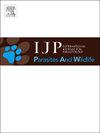南普度(普度普达)的耳检测cynotis (Acari: Psoroptidae)侵染:一种意想不到的寄主-寄生虫记录的原位和非原位数据
IF 2.2
3区 医学
Q3 ECOLOGY
International Journal for Parasitology-Parasites and Wildlife
Pub Date : 2025-01-28
DOI:10.1016/j.ijppaw.2025.101043
引用次数: 0
摘要
耳虫(Acari: Psoroptidae)是一种专性的、非穴居的体外寄生虫,主要在家养和野生食肉动物中引起耳虫病。到目前为止,只有很少的研究描述了这种寄生虫在食草动物宿主中的情况。在本研究中,我们报告了在世界自然保护联盟(IUCN)列为近危红色名录的南普度(Pudu puda)的cynotis侵染。在智利自由放养的动物(原地)以及德国伍珀塔尔动物园饲养的普多斯(非原地)中发现了耳嗅虫。在临床工作中,在智利瓦尔迪维亚的Rehabilitación de Fauna Silvestre中心(CEREFAS),观察到两个自由放养的阴唇暂时恢复,耳廓和外耳道内出现低至中度黄褐色分泌物和结痂,并伴有炎症性外耳炎。光镜下发现有革螨,经形态学和分子分析鉴定为cynotis。在伍珀塔尔动物园,2015年至2024年在15只pupus中检测到耳螨,然而,在2023年至2024年的本研究中,在4只动物中进行了明确的物种鉴定(O. cynotis)。一些受影响的脓肿在耳朵和头部周围出现秃斑,并表现出摇头行为,而另一些则无症状。在某些情况下,螨虫是由于其他原因在全身麻醉下进行临床检查时发现的次要发现。据我们所知,这标志着首次通过形态学和分子鉴定相结合的方法报道了脓毒虫在浦地的侵染。我们在此提供了原位和非原位的临床数据,并表明动物园和野生动物康复中心在研究和监测被忽视的野生动物疾病方面发挥了重要作用。本文章由计算机程序翻译,如有差异,请以英文原文为准。

Otodectes cynotis (Acari: Psoroptidae) infestations in Southern pudus (Pudu puda): In situ and ex situ data of an unexpected host-parasite record
Otodectes cynotis (Acari: Psoroptidae) constitutes an obligate, non-burrowing ectoparasite and causes otodectic mange primarily in domestic and wild carnivores. Only few studies have described this parasite in herbivore hosts so far. In the current study, we report O. cynotis infestations in Southern pudus (Pudu puda), categorized in the IUCN red list as near threatened. Otodectes cynotis was detected in free-ranging animals in Chile (in situ), as well as in zoo-housed pudus at the Zoo Wuppertal, Germany (ex situ). During clinical work, two free-ranging pudus temporarily rehabilitated at the Centro de Rehabilitación de Fauna Silvestre (CEREFAS), Valdivia, Chile, were observed with low to moderate yellowish-brown secretions and encrustations inside the pinna and external auditory canal accompanied by an inflammatory Otitis externa. Analysis via light microscopy exhibited the presence of mange mites, which were identified as O. cynotis via morphological characteristics and molecular analysis. At the Zoo Wuppertal, ear mites were detected in 15 pudus between 2015 and 2024, however, a definite species identification (O. cynotis) was carried out in 4 animals within the current study between 2023 and 2024. Some affected pudus showed bald spots around the ears and the head and exhibited headshaking behavior, whilst others were asymptomatic. In some cases, mites were found as a secondary finding when clinical examination under general anesthesia was performed for other reasons. To the best of our knowledge, this signifies the first report of O. cynotis infestations in pudus by combining morphological and molecular identification. We here present clinical in situ and ex situ data and show that zoological gardens and widlife rehabilitation centers play an important role in research and monitoring of neglected wildlife diseases.
求助全文
通过发布文献求助,成功后即可免费获取论文全文。
去求助
来源期刊

International Journal for Parasitology-Parasites and Wildlife
Medicine-Infectious Diseases
CiteScore
3.80
自引率
5.60%
发文量
113
审稿时长
45 days
期刊介绍:
The International Journal for Parasitology: Parasites and Wildlife (IJP-PAW) publishes the results of original research on parasites of all wildlife, invertebrate and vertebrate. This includes free-ranging, wild populations, as well as captive wildlife, semi-domesticated species (e.g. reindeer) and farmed populations of recently domesticated or wild-captured species (e.g. cultured fishes). Articles on all aspects of wildlife parasitology are welcomed including taxonomy, biodiversity and distribution, ecology and epidemiology, population biology and host-parasite relationships. The impact of parasites on the health and conservation of wildlife is seen as an important area covered by the journal especially the potential role of environmental factors, for example climate. Also important to the journal is ''one health'' and the nature of interactions between wildlife, people and domestic animals, including disease emergence and zoonoses.
 求助内容:
求助内容: 应助结果提醒方式:
应助结果提醒方式:


